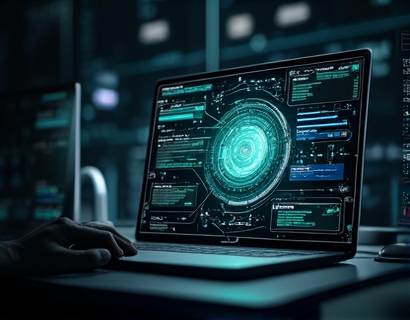Unlocking Digital Efficiency: Harnessing AI and Crypto for Next-Gen Productivity and App Accessibility
The integration of Artificial Intelligence (AI) and cryptocurrency is revolutionizing the digital landscape, offering unprecedented levels of productivity and app accessibility. This fusion of technologies is not just a trend but a transformative shift that is redefining how we interact with digital tools and manage tasks. For tech enthusiasts and early adopters, understanding this synergy is crucial to staying ahead in the rapidly evolving tech world.
The potential of next-generation productivity tools lies at the intersection of AI and cryptocurrency. AI brings intelligent automation, predictive analytics, and personalized user experiences, while cryptocurrency provides a decentralized, secure, and efficient means of transaction and data management. Together, they create a powerful ecosystem that enhances app functionality and user engagement.
AI-Driven Productivity Enhancements
AI technologies are transforming productivity by automating routine tasks, providing intelligent recommendations, and optimizing workflows. Machine learning algorithms can analyze vast amounts of data to identify patterns and predict outcomes, enabling users to make informed decisions quickly. For instance, AI-powered virtual assistants can manage schedules, prioritize tasks, and even draft emails, freeing up valuable time for more critical activities.
Moreover, AI-driven tools can adapt to individual user preferences and behaviors, offering a personalized experience that enhances efficiency. Smart suggestion engines can propose actions based on past behavior, while natural language processing (NLP) enables seamless communication between users and applications. These advancements not only streamline workflows but also improve overall productivity and job satisfaction.
Cryptocurrency and Decentralized Applications
Cryptocurrency, particularly through blockchain technology, is reshaping app accessibility and data management. Blockchain's decentralized nature ensures transparency, security, and immutability, making it an ideal foundation for trustless transactions and data storage. Decentralized applications (dApps) built on blockchain can operate without intermediaries, reducing costs and increasing reliability.
One of the key benefits of using cryptocurrency in digital tools is the elimination of traditional payment gateways and financial intermediaries. This not only speeds up transactions but also reduces fees and enhances security. For developers and users, this means a more streamlined and efficient experience when accessing and utilizing digital services.
Synergy of AI and Cryptocurrency
The true power of AI and cryptocurrency is realized when they are combined. AI can leverage blockchain's secure and transparent data storage to enhance its capabilities. For example, AI models can be trained on decentralized datasets, ensuring data privacy and integrity. This synergy enables the creation of more robust and trustworthy applications.
Smart contracts, a core feature of blockchain, can automate and enforce agreements between parties without the need for intermediaries. When integrated with AI, smart contracts can execute complex tasks based on predefined conditions, further automating processes and reducing human error. This combination is particularly useful in areas like supply chain management, where transparency and efficiency are paramount.
Enhanced App Accessibility
The fusion of AI and cryptocurrency is also making digital tools more accessible to a broader audience. Traditional app stores often have stringent requirements and centralized control, which can limit innovation and user choice. Decentralized platforms, powered by blockchain, allow developers to publish and distribute applications directly to users, bypassing these barriers.
AI can further enhance accessibility by providing personalized user interfaces and adaptive learning features. For instance, AI-driven accessibility tools can convert text to speech, recognize voice commands, and adjust display settings based on user preferences. These features ensure that digital tools are usable by people with diverse abilities and needs.
Case Studies and Real-World Applications
Several projects are already demonstrating the potential of AI and cryptocurrency in enhancing productivity and app accessibility. One notable example is a decentralized task management platform that uses AI to optimize task allocation and prioritize work based on user availability and skill sets. This platform leverages blockchain to ensure data integrity and secure user interactions, while AI ensures that tasks are assigned efficiently and effectively.
Another example is a cryptocurrency-powered content creation platform that uses AI to curate and monetize user-generated content. The platform rewards creators with native tokens based on engagement metrics, ensuring a fair and transparent reward system. AI algorithms analyze content performance and suggest improvements, while blockchain ensures that creators retain ownership and control over their work.
Future Prospects and Challenges
The future of digital tools is bright, with AI and cryptocurrency set to play pivotal roles in shaping the next generation of productivity and app accessibility. However, there are challenges that need to be addressed to fully realize this potential. Regulatory frameworks must evolve to accommodate decentralized technologies, ensuring user protection and market stability. Additionally, there is a need for greater education and awareness among users to adopt and leverage these advanced technologies effectively.
Technical challenges, such as scalability and interoperability, also need to be overcome. As more applications and services integrate AI and blockchain, ensuring seamless interactions and high performance will be crucial. Continuous research and development in these areas will drive innovation and enhance user experiences.
Conclusion
The convergence of AI and cryptocurrency is unlocking new dimensions of digital efficiency, productivity, and app accessibility. By harnessing the strengths of both technologies, we can create a more inclusive, secure, and efficient digital ecosystem. For tech enthusiasts and early adopters, embracing this synergy is not just an option but a necessity to stay relevant and competitive in the future of technology.










































